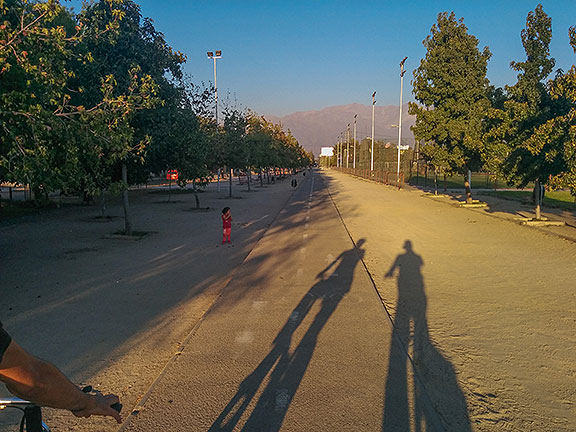
Ricardo Jerez and I bicycling on a path towards his home in Santiago, the Andes looming in the distance.
It still is, isn’t it?
It is in some places, less so in others. In Latin America, from Chile and Brazil to Colombia, Panama, Peru, Ecuador, and Mexico, it is going strong. But I had an insight during the two weeks I recently spent in Chile at the Forum Mundial de Bicicleta 5 (#FMB5). Amidst presentations on all matters bicycle-related, from street designs and accessibility, to the important feminist impulse that is pushing many women to use the bicycle as a literal vehicle of personal emancipation (echoing their 19th century ancestors), to countless presentations on urban planning and livable cities, it suddenly dawned on me that we’re living through a very specific period of history. From about 1990-2020 we are transitioning from the twentieth-century commitment to automobiles to a multi-modal approach to urban transportation that foregrounds bicycling and walking, supplemented by public transit.
To be sure there are still strong political and economic forces putting up major resistance to this transition, especially given the central role of the automobile and oil industries in most industrialized economies. But literally millions of citizens across the world are “voting” on this directly by getting on bicycles and changing their daily behavior. This didn’t erupt from a policy decision on-high by some bureaucrat, but rather an urgent need by people in cities everywhere to address the ridiculous irrationality of endless traffic congestion, horrible air pollution, catastrophic collisions, neighborhoods devastated by being engineered to accommodate maximum space for high speed car use and no-speed car parking, perpetual indebtedness to pay for car costs, and so on. As social solidarity has been torn apart in societies everywhere by the horrible consequences of neoliberal capitalism and austerity, a new kind of solidarity around the embrace of the bicycle has helped many to find a remarkably joyful connection to their sister and brother cyclists.
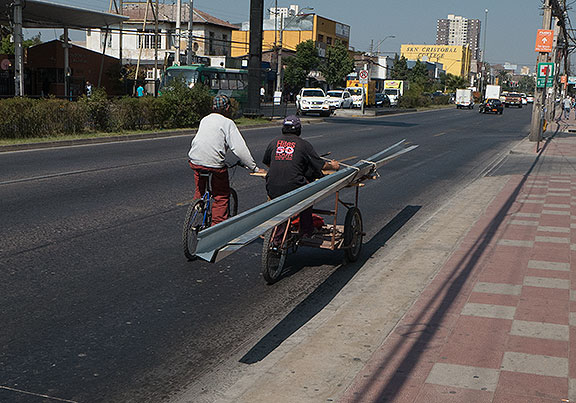
Practical bicycling… the kind that doesn’t really show up in the “bicycling culture” which tends to be a middle- and upper-middle class phenomenon in most places.

Santiago has some very decent bike lanes already, and some weirdly obsolescent ones… this one on Rosas was my favorite.
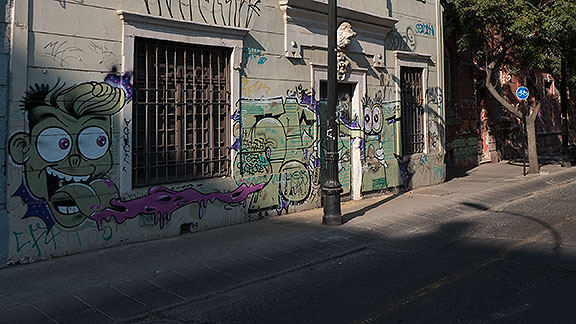
The sloping granite blocks between sidewalk and street are designated a bike-only space! Never saw anything like that before.
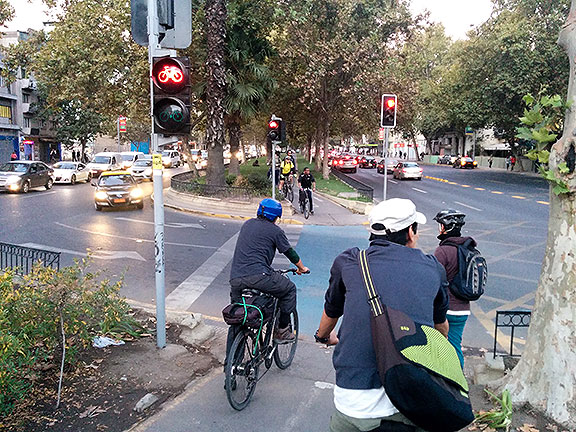
An early bike lane in Santiago runs along the center median of the Alameda, but it is full of obstacles and strange twists and turns… more of an add-on that wasn’t really designed for bicycle traffic.
This “bike culture solidarity” is largely a middle- and upper-middle-class phenomenon. Poor people have been bicycling through the whole of the 20th century without making a political or cultural issue of it. Once the bike culture started to catch on during the past generation, it took root among the parts of the population who were perhaps most separated from the kind of everyday solidarity that has always been the hallmark of poorer communities. In places like Mexico, it is still not uncommon to hear people dismiss so-called “backward” small towns as “Pueblos Bicicleteros,” to denote their lack of modernity. But in a delicious turnabout, those towns can now claim to have leapfrogged the stupidity of 20th century modernism to embrace a fully modern 21st century sensibility rooted in a shared and ecologically grounded consciousness, and at ease with self-propelled mobility as a sensible first choice in lieu of oil-and-auto dependency.
During the two weeks I was in Chile, mostly in Santiago. I was immersed in a city that has a dynamic, albeit fragmented, bike culture, and for its participants there is a powerful allure, a romance, and a compelling sense of solidarity and belonging. The city hosted the Forum Mundial de Bicicleta 5 (#FMB5) which is tellingly not a particularly world forum as much as a Latin American one. It started five years ago in Porto Alegre, Brazil where it continued the following year, then moved a bit north to Curitiba, Brazil for the third installment. There the participants narrowly voted to hold the fourth meeting (in 2015) in Medellin, Colombia, and in Colombia the participants voted at the conclusion to hold this year’s in Santiago, Chile. At the conclusion of our five days in Santiago we collectively decided to hold 2017’s in Mexico City, and 2018’s in Lima, Peru.
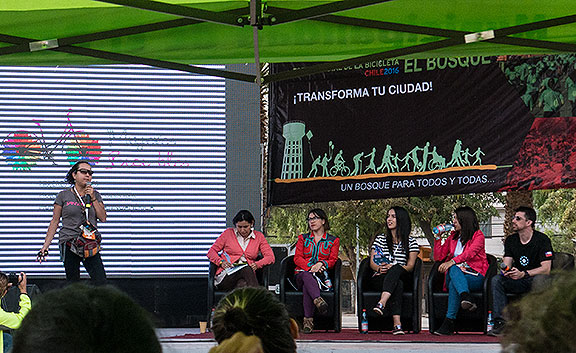
Mujeres en Bici presenting at El Bosque, one of four sites where the World Bike Forum was held in Santiago. Their book on women cycling is here.
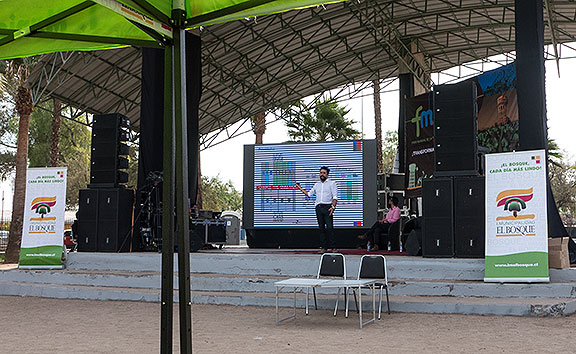
Another presentation at the FMB5 on urban transit sustainability…
I gave a Talk at the Santiago FMB, and was treated with enormous respect and enthusiasm, far beyond anything I actually deserve, mostly because of the skewed notion that I am the founder or creator of Critical Mass (which I spend a lot of time trying to dispel—but the more I deny it the more some people are sure it must be true!). The bike culture needs some heroes to rally around (apparently) and I have been thrust into that role (an “accidental diplomat” as my essay in Shift Happens: Critical Mass at 20 describes it), along with Gary Fisher and a few others who are semi-regular at these confabs. But the point of my attendance in Santiago was to give what I internally imagined as my “farewell” address to bicycling politics, but now I realize probably wasn’t. I called it “If Bicycling is the Key, What Does it Unlock?” and brought there the argument that I’ve been making for a long time, that bicycling is not enough of a rallying point, in and of itself.
As I shared this with the many wonderful friends I have in the real community of Latin American cyclists a lot of them were quick to agree. But I don’t think any of us have really thought through the implications of what it means. I think that the experience I’ve had in San Francisco is an important reference point. About two or three dozen of us initiated Critical Mass nearly a generation ago (in 1992) and had the enormous pleasure of watching it spread across the planet as a contagious, self-replicating meme in just a few years. By 1994 there were many Critical Masses, but even more interesting was that so many people were starting bicycling clubs, bike kitchens, bike ballet groups, bike circuses, midnight rides, bike cafes, and producing an endless stream of zines, hats, stickers, posters, buttons, and a remarkable profusion of bike-related creative expressions. By the turn of the 21st century that culture was in demise, and now, in 2016, it has practically disappeared.
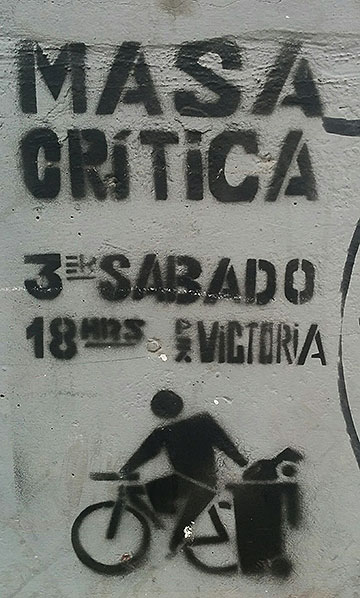
This stencil is on the wall in Valparaiso, Chile, which has a small but dynamic bicycling community.
Here in San Francisco, bicycling has also boomed since the early 1990s. We’ve had an enormous increase in daily bicycling trips during this period. As bicycling became normalized for tens of thousands of people, what was once a dynamic bicycling culture has largely disintegrated. Critical Mass still rolls every month but it has been quite a long time since I thought it magical or inspiring. Generally it is a very predictable and rather boring ride these days without much conversation or discussion. The local Bike Kitchen is still going strong, though it is in an expensive space that has thrust a certain degree of normality onto its once intangible essence. Dozens of bike shops are doing well here as small businesses; new separated, buffered, painted bike lanes are opening here and there though we are far from a comprehensive network of functional bikeways separated from streets dominated by cars.
There are still some independent efforts to use the bicycle in politically interesting ways. The activist group PODER has organized Bicis del Pueblo, which holds monthly bike building workshops, organized group rides, and more to serve the largely Latino population of the working class, southern part of San Francisco. In Los Angeles the Ovarian Psycos are an all-female posse of cyclists who are pushing boundaries of both gender and racial exclusion in the bike scene down there. Bicycles continue to provide a means for social groups to assert their independence, their opposition to the dominant culture, and to enact a partial agenda of urban transformation. But bicycling has been aggressively captured, too, by monied interests committed to the preservation and extension of existing dynamics of power and wealth.

A Santiago cyclist lampooning the absurdity of “mandatory helmets” or “cascos obligatarios” in Spanish, taken before the 10,000-strong Critical Mass in Santiago, April 5, 2016.
A substantial number of cyclists in the Bay Area and beyond have chosen to participate in monthly “Bike Parties” which emerged as a response to the sense that Critical Mass rides were too anarchic and “out of control.” They are designed to follow the rules of the road, to stop regularly for party breaks, have a self-organized group of monitors to usher the ride along, and assiduously ignore any political discussions or ideas. To its credit, the East Bay Bike Party has brought thousands of young riders together for long night rides through the area, characteristically very racially diverse unlike the overwhelmingly white Critical Mass rides.
Alongside the proliferation of daily bicycling another emergent innovation is the parklet, reclaiming parking spaces from metered car parking to be used as micro-public parks. Often they are installed in front of bicycle shops and cafes, helping to reinforce the cultural transformation towards more conviviality embodied in those types of small businesses. But they have their opponents too, especially among the activists combating gentrification and displacement of communities of color, since the parklets tend to be anchors for precarious young white workers who spend a lot of time on computers in public. Rarely do day laborers or house cleaners have a moment to sit down and enjoy a coffee in a parklet, even in neighborhoods where many thousands are employed, and in spite of these parklets being clearly labeled as public spaces and not privately owned by the adjacent business.
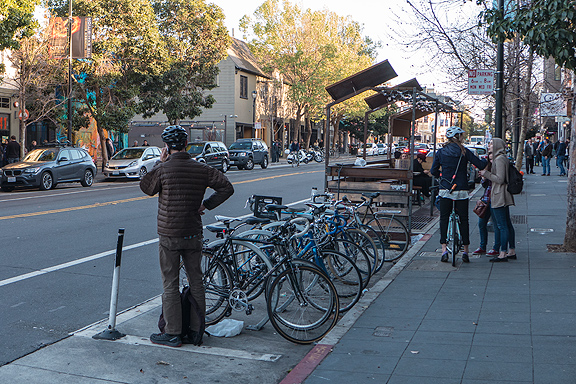
This parklet on Valencia in San Francisco features ample bike parking and cozy wooden benches.

The stark demographics of San Francisco show up as two luxury buses dedicated to shuttling tech workers from SF to their workplaces in Silicon Valley cruise by a bicycle-filled parklet in front of the collectively-run bakery Arizmendi.
The 25-year trajectory of bicycling culture in San Francisco cannot be understood apart from the primary advocacy organization in the City, the San Francisco Bicycle Coalition (SFBC). When Critical Mass began in 1992 the SFBC was a group of about 15+ volunteers who met once a month in the back of a Chinese restaurant. About a year later they took the leap to renting an office and formalizing a paid director and part-time staff. After the police attack on Critical Mass in 1997 the SFBC enjoyed a sudden influx of new members and within a year had grown to more than a thousand dues-paying members for the first time. By 2000 the new executive director was pushing the growth of membership as a strategy while she was damping the grassroots activism of the organization in favor of a more typical hierarchical organization. By the mid-2000s the SFBC had surpassed 5,000 members and by 2010 it had reached 10,000. The Executive Director’s leadership was rewarded with appointments to representative positions on the SF Municipal Transportation Agency and the Golden Gate Bridge, Highway & Transportation District. The organization gained financial and political support from foundations, corporations, and governmental agencies and its budget soared to well over a half million dollars a year. Politicians sought its endorsement during each election cycle, and that power-to-endorse became an important arrow in the SFBC’s quiver—though we have to say, too, that the politicians that gained support from the Bicycle Coalition have not produced a comprehensive transformation of city streets, or even a significant fraction of them, to accommodate daily cycling.
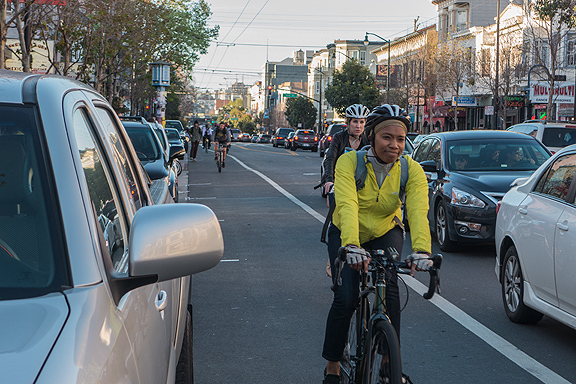
At its best, the much-bragged about Valencia Street bike lanes have enjoyed a boom in daily cycling. This photo was taken moments after the following ones when cyclists could not ride through the Uber and Lyft drivers who routinely block the bike lane in this block as they troll for riders.
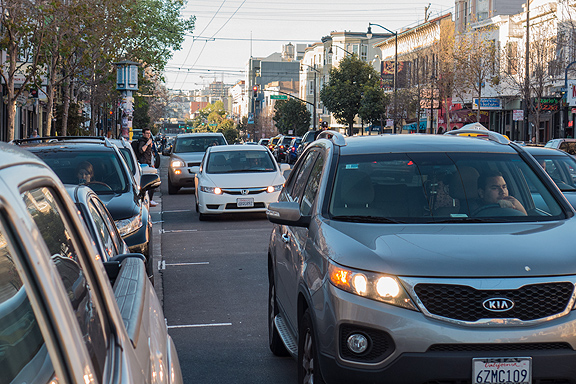
Same spot, 5 minutes earlier.
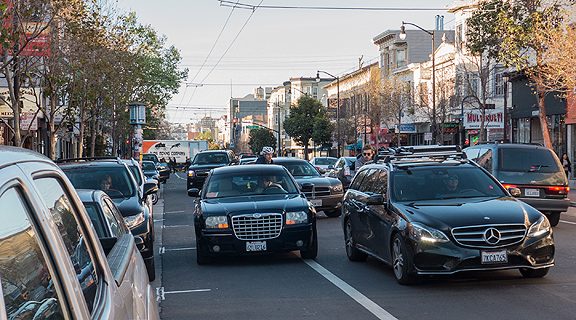
Even though San Francisco has enjoyed a boom in cycling, it’s not thanks to the infrastructure, which still overwhelmingly favor the private automobile (and there is practically no enforcement along here).
Over two and a half decades this organizational evolution provides a revealing window into the co-optation of what was a radical movement of bicyclists into a relatively conservative and cautious organization run in a strict top-down manner to ensure nothing unpredictable rocks the efforts to normalize and mainstream bicycling. Of course this could only be true in part because there are no other San Francisco organizations of bicyclists to speak of. For a brief time in 1997 and early 1998 a small group called “Grip” staged some interventions and sought to develop an action-oriented group of cyclists committed to engaging in local political fights. But that effort petered out after less than a year. Critical Mass riders have eschewed any organizational efforts as Critical Mass because ultimately Critical Mass is an event, not an organization. Participants have shown little interest in more formal organizations beyond those who have become members of the San Francisco or East Bay Bicycle Coalitions. These days there are fewer regular riders than newbies and visitors, a further structural reason why organization does not emerge from the event.
The expansive, participatory, and utopian qualities that characterized the first years of Critical Mass rides gave way over time to ossification and repetitiveness within Critical Mass itself. The political space of bicycling outside of Critical Mass has been filled by the SFBC which subsumed “activism” into free labor for a hierarchical lobbying corporation pushing a “pro-bike” agenda. Jason Henderson, writing in his excellent book Streetfight: The Politics of Mobility in San Francisco, argues:
“The original agenda of the SFBC, closely aligned to the Critical Masses of the 1990s, had its roots in a broad criticism of automobility, but the new SFBC took pains to stress that the majority of its membership owned cars and yet chose to bicycle. The SFBC of the nineties was characterized by a leadership that offered progressive critiques of the geography of capitalism and of a lifestyle centered on unfettered hyperconsumption, the incessant speeding up of everyday life, competition rather than cooperation, and possessive individualism rather than collective action: in other words, a critique of neoliberalism and conservatism.
In 2012 the new SFBC was sponsored by large corporate foundations whose wealth came from capitalist investments, and this included a who’s who of San Francisco and Silicon Valley businesses and entrepreneurs. Among them, Google, Microsoft, Pacific Gas & Electric, an array of private transportation, urban planning, and architectural consultants, real estate firms, attorneys, and individual donors connected to software and social networking firms. The organization maintained a very large volunteer base as well, one that provided some sixteen thousand hours of free work, and 26 percent of its income came from the fees of its thousands of progressively inclined individual members… In addition, despite the large corporate and foundation financing, the SFBC relied heavily on in-kind support from hundreds of independent small businesses such as restaurants, bicycle dealers, bars and cafes, and other small-scale retailers.” (p.133-134)
With this increase in budget and profile, the SFBC earned its money by becoming a meek team player for local interests, hoping for handouts from their benefactors. With regard to a real bicycle agenda, they have acquiesced to a glacial effort to transform bicycling corridors throughout the city (losing the argument for the primary north-south artery on Polk Street to cranky condo residents and car-loving bar owners). The difficulty of crossing the bay by bicycle has been exacerbated by the SFBC and East Bay Bike Coalitions, who both have abdicated to the state’s traffic engineers at Caltrans. Caltrans’s proposal is for 10-year project to cost $1 billion that will attach an external dual-use bike and maintenance lane to the west span of the Bay Bridge to connect San Francisco to the middle of the Bay and the other half of the recently built Bay Bridge bike lane. Ignored in this acquiescence is the easy and cheap alternative of having the west span returned to its original 6 lanes with one reserved for cyclists for a budget less than 0.5% of the cost of the other approach. The SFBC and EBBC both ignore the vital history of the San Francisco Freeway Revolt that halted freeway construction through the City in the early 1960s, at the exact time when the Dept. of Highways (rechristened Caltrans years later) was reconfiguring the Bay Bridge to connect to a high-speed freeway system that was never built.

The halfway “bike pier” on the eastern span of the Bay Bridge… closed!
So to my friends in Latin America and bicycling enthusiasts in the U.S. and Europe who are still enjoying the golden era of bicycle culture in your respective countries: beware a future of integration and capture by the rich, the developers, and their political friends. Bicycling is a movement today, but tomorrow it will just be a way to get around… unless we can fuse bicycling with a more expansive agenda that challenges the logic of incessant growth, a world based on commodification of humans and their creativity, and the reduction of nature to “resources.” A deeper agenda lurks within our spinning wheels but can slip away quite easily if we give way to the narrow common-sense agenda of those who can’t see the forest for the trees, who can’t see that bicycling is just a doorway to a much larger transformation of how we make life together.
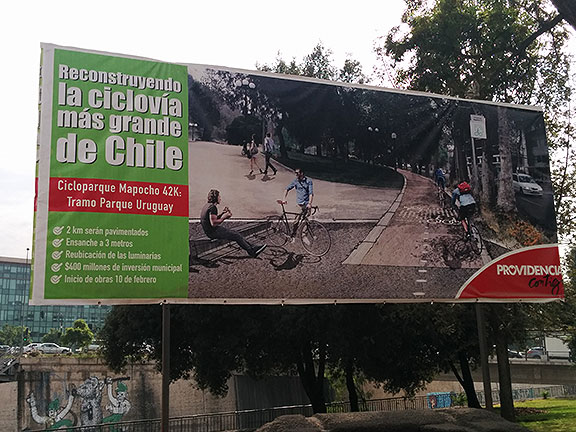
The Intendente of Santiago, Claudio Orrego, is pushing this 42-km bikeway along the Rio Mapocho, which enjoyed a staged opening at the beginning of the FMB5.
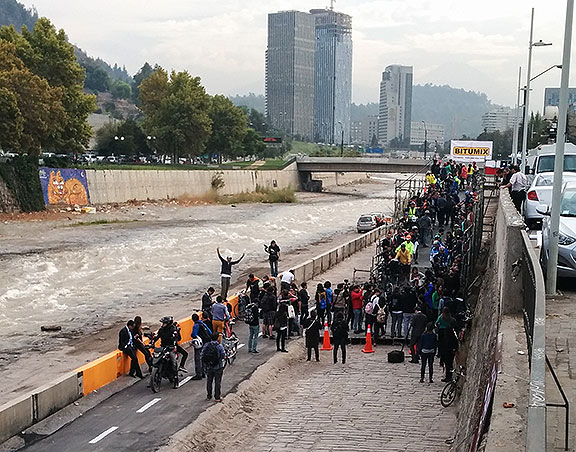
The opening ceremony.
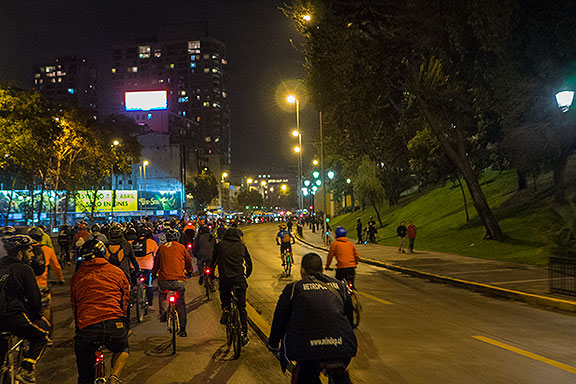
Critical Mass, Santiago, Chile, April 5, 2016
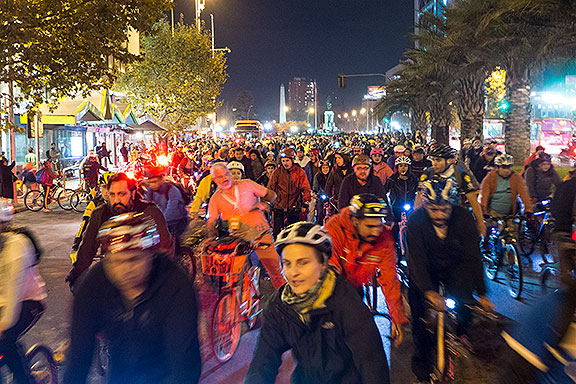
Critical Mass
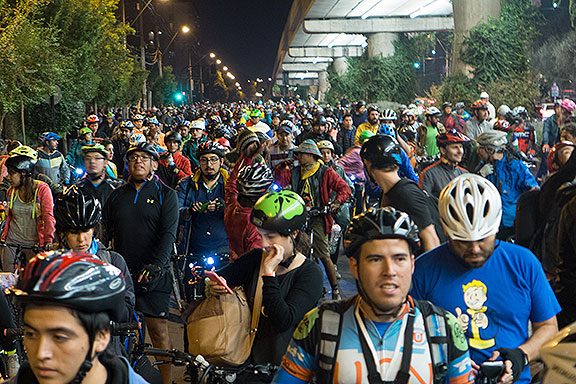
Critical Mass
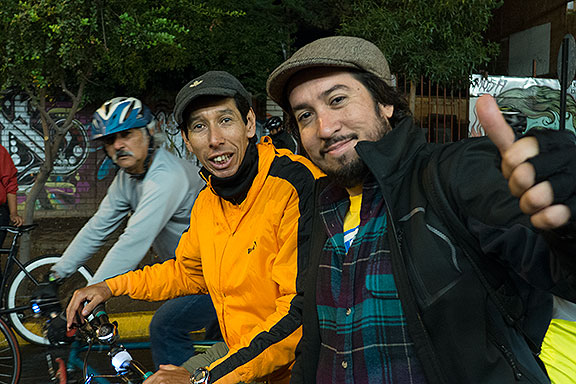
Lucas from Argentina, and Ricardo from Santiago at Critical Mass
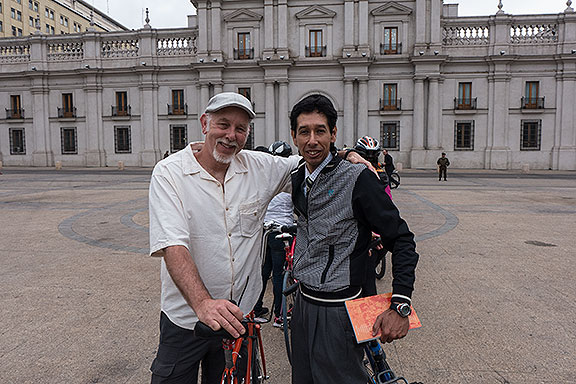
Me and Ricardo getting ready to enter La Moneda, for the unexpected and very strange meeting with the President of Chile!
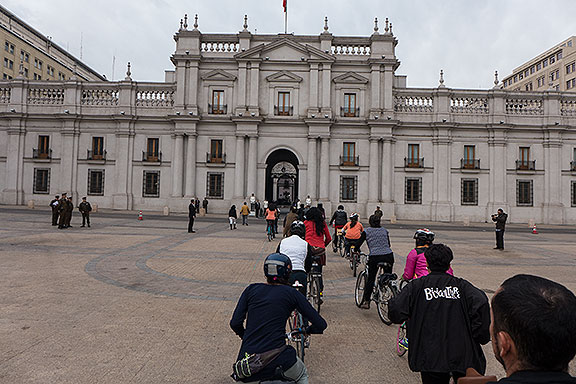
Riding in to La Moneda
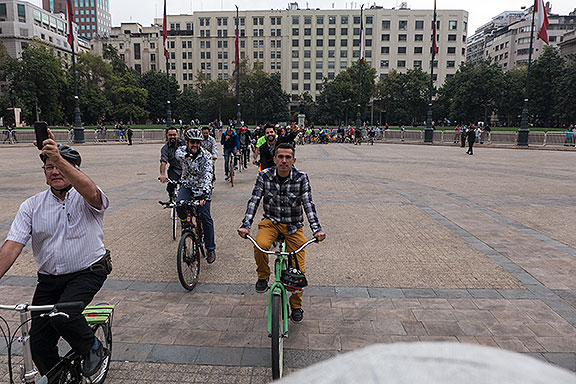
About 50-60 of us went in on bikes to the central courtyard…
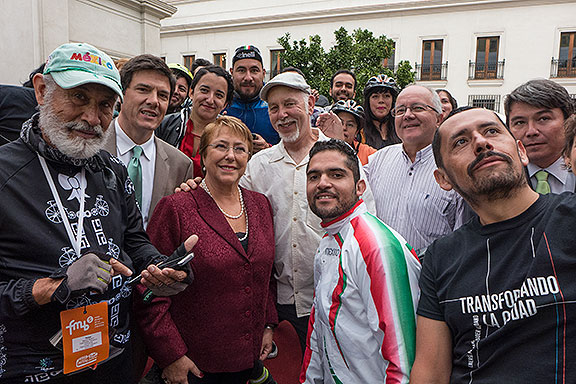
with President Bachelet of Chile… !
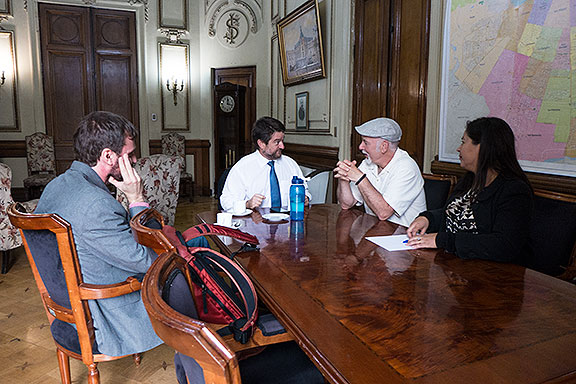
Meeting with Claudio Orrego and Rodrigo Nunes in the Intendente’s office.
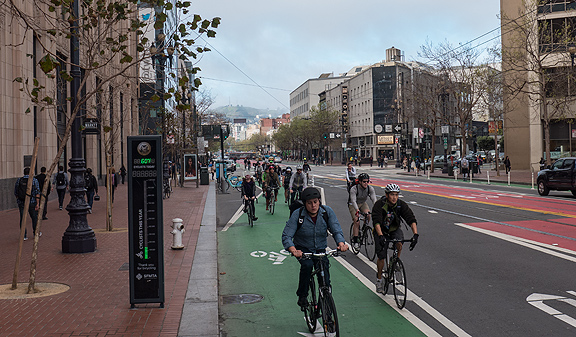
Back in San Francisco, the morning bike commute in front of the Twitter building…












Daniel, I agree with all your points. I’ve never been to Recife but your observations can be said of many cities that I’ve been in.
Chris, your views re the San Francisco Bicycle Coalition (SFBC) are on point. Some of us remain members in hopes of a return to its radical grassroots. However, I should offer a correction. Before the SF city government attacked Critical Mass at the July 1997 Mass, the SFBC numbered about 2,000 members. I remember the infamous City Hall meeting where a Supervisor represented the mayoral administration (a member of the legislative branch “representing” the executive branch – such is the post-democratic era we live in). SFBC claimed to “represent” Critical Mass. It was pointed out by a bike messenger there that an organization of 2,000 members couldn’t represent an event of 7,000 people. The 2 messengers were there only to make sure we weren’t scapegoated – and it worked! But SFBC sold out for a few bike lanes and another point that escapes my memory. They violated both rules of political dealing: 1. Don’t sell out. AND 2. If you really, really feel that you must sell out … don’t sell out cheap! I asked the SFBC reps not to accept this “deal” and that it wouldn’t work on the street. You know the rest.
There still is bike culture in SF when we have the Ride of Silence held the 2nd Wednesday of every May. That ride is to silently honor the memories of cyclists slain on the streets of SF. That same day Rides of Silence are held in other cities all around the world.
Very good thoughts. Very good talks.
Here in Recife, bicycle is being captured by (not so much friends) politians and by capitalism. Politians made people think that bicycles are for leisure only. Capitalism sell anything with the bicycle image: t-shirts, food, buildings and… yes… and cars.
If we don’t keep strong, bicycle will be the simbol of everything that could be saw by the window of your car in the middle of a jam.